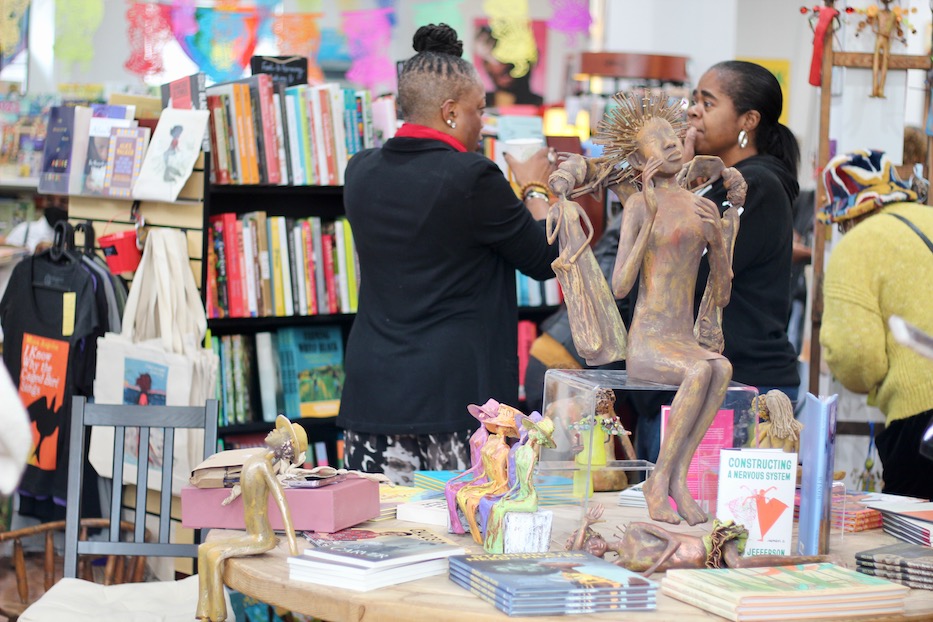
Books | Poetry | Arts & Culture | Whalley/Edgewood/Beaver Hills | Sculpture | Arts & Anti-racism | Possible Futures
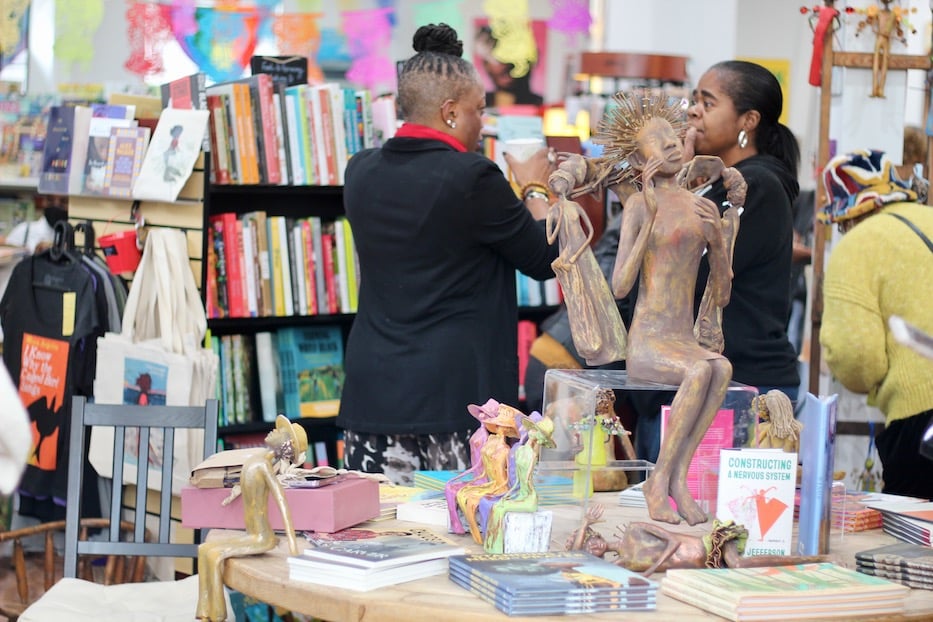
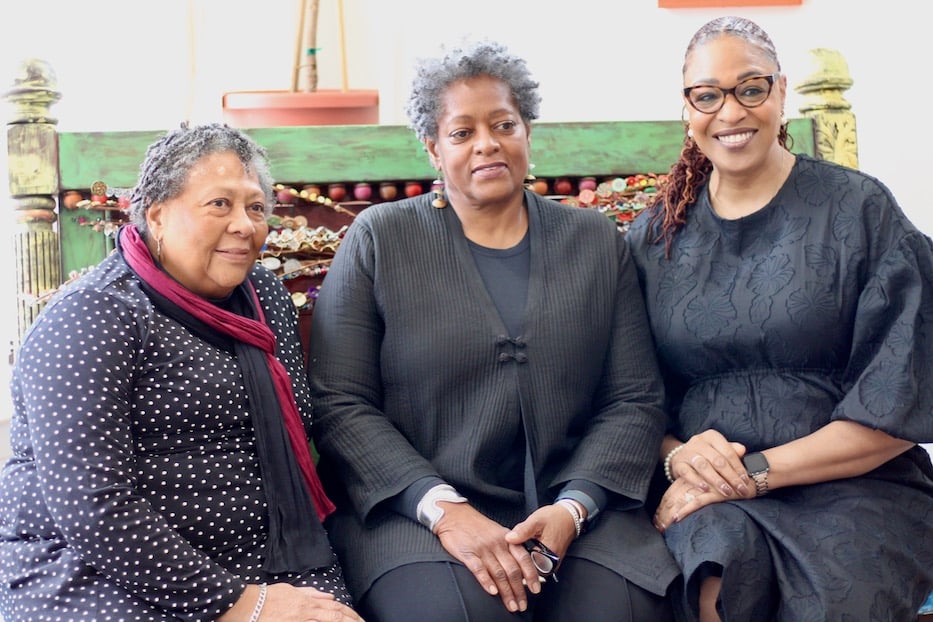
Top: Some of the sculptures on display. Bottom: Marilyn Nelson, Linda Mickens, and Antoinette Brim-Bell. Lucy Gellman Photos.
Marilyn Nelson sat back against a pair of dazzling wire-and-bead wings, and summoned the spirit of sculptor Augusta Savage. Halfway across the room, an angel sat between the books A Wreath for Emmett Till and Lubaya's Quiet Roar, her head bowed in prayer. Beside her, sculptures of tiny women in wide-brimmed hats transformed into a rainbow of color. Nelson cracked open the spine of a book, and began to read.
Sacred and secular met at Possible Futures bookspace last Saturday, as poets, artists, chefs and community members gathered for “Everyday Angels,” a poetry reading, art exhibition and brunch. The brainchild of Possible Futures, Elm City LIT Fest and Hamden’s Amplify The Arts festival, the event brought together sculptor Linda Mickens, Connecticut Poet Laureate Anotoinette Brim-Bell, and former Connecticut Poet Laureate Marilyn Nelson. Samad Mickens, who owns and runs Beyond the Salt Truck, provided food for the event.
Mickens’ sculptures will remain at Possible Futures at 318 Edgewood Ave. through the end of the month. A suite of “Everyday Angel” awardees, recognized as hometown heroes by friends and fellow attendees, included longtime educator Lensley Gay, Elm City Communities Executive Director Karen DuBois-Walton, International Festival of Arts & Ideas Program Manager and Elm City LIT Fest Co-Coordinator Shamain McAllister, Keefe Center Director Sharon Jones, and Inner-City News Editor and WNHH Community Radio host Babz Rawls-Ivy.
“It’s not necessarily this mystical thing. It really is more about the everyday people that show up and lend kind words, do acts that you don’t even know why,” said Mickens’ daughter Karimah, who runs Amplify the Arts and serves as Hamden’s town clerk. “That intent of today is just to be in that space of inspiration. I think it’s a good time, it’s the beginning of a new year, and hopefully you’ll walk away with that word, inspired.”
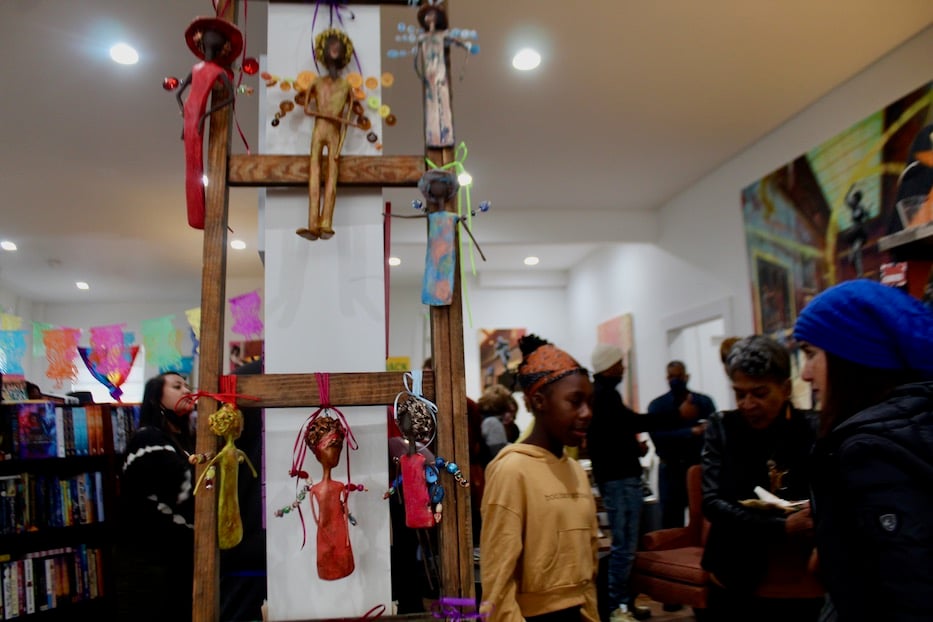
Throughout the morning, artists summoned a raft of angels, both earthly and not. Mickens, a sculptor and recently retired nurse whose career stretches back decades, told attendees that her interest in sculpting angels began in the 1980s, when she was on a trip to Jamaica to hike the Blue Mountains with friends. At the time, she was waiting for a bus when a woman approached her, asking for socks.
Mickens realized the only socks she had were the ones she had on. Spotting a store nearby, she offered the woman money to buy socks instead. The woman pushed back, stressing that she hadn’t asked for money. Mickens turned to get on the bus.
"It was like this beautiful light, a prism of colors, but very pastel-y," she said. "And it felt like time had stopped. I don't know how I sat on the bus or how I got there. It was just love surrounding me all over. It lasted maybe five or seven minutes and then I came back, and I'm on the bus."
To this day, she can't remember getting on the bus. She sat for a moment, wondering what had happened to her. "My interpretation was that I met an angel," she said. "I met an angel that gave me the gift of love. I think that they're here with us, on an ancestral level. They're everyday people."
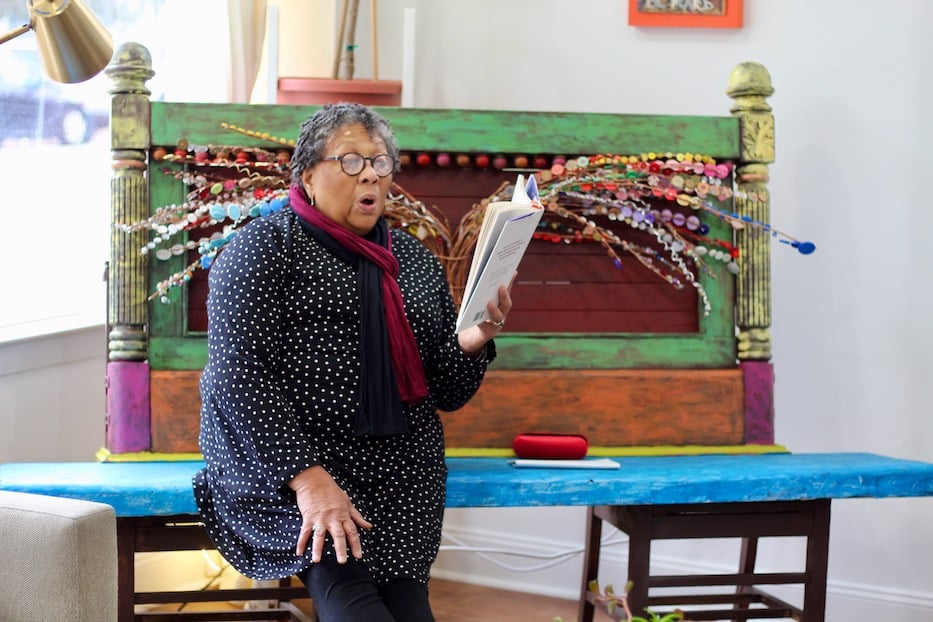
It was an introduction to the small blessings that weave through everyday life, and often define New Haven. So too as Nelson took a seat on the bench, a painting from the artist Shaunda Holloway perched just above her head.
Nelson said that she hadn’t decided what to read until coming into the space, and spending time with Mickens’ work. It was there, looking over the pieces, that she settled on selections from her collection Augusta Savage: The Shape of a Sculptor's Life. On hearing the sculptor’s name spoken aloud, Mickens beamed. She later squealed in delight when Possible Futures owner Lauren Anderson gifted her a copy of the book.
“She had such a tremendous struggle to be recognized … not to be recognized, to be allowed to be an artist,” Nelson said. “To be allowed to be an African American woman artist. And it looked like all the doors were closed to her.”
As she took a seat on the bench, Nelson traced Savage’s extraordinary path from small-town Florida to New York City to Paris and back to New York again. The middle of 14 children, Savage was “beaten for making art” by her father, Nelson said. And yet, she pursued it, ultimately heralded for her craft and sometimes maligned for it too.
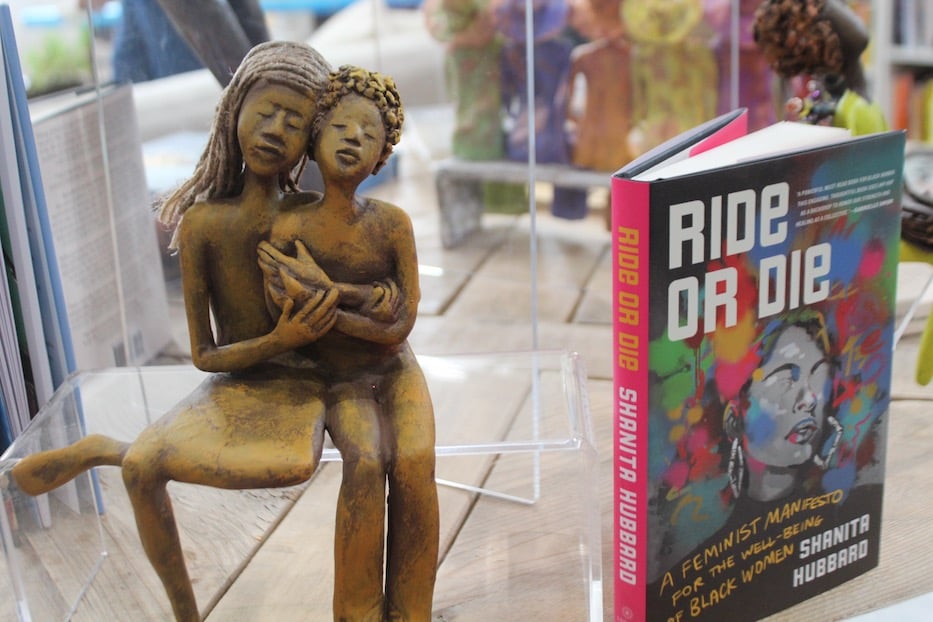
Starting in Savage’s young voice, she traced a line from the enslavement of Black people to Savage’s own childhood and adolescence to her budding and tumultuous career in New York. In her writing, Nelson often uses concrete poetry; she turned the page to show the thick outline of a duckling in reference to the poem.
It was a nod to Savage, who made history as a sculptor, yet had to fight for recognition from her family and the public alike until her death in 1962.
“I was thinking that I should sculpt the poems,” Nelson said before returning to the page. Around the room, Mickens’ paper-and-paint sculptures sat still, waiting with open ears.
Attendees listened as Nelson guided them through Savage’s life, from her studies at Cooper Union to the opening of her gallery in New York. They murmured as Nelson described Savage’s Floridian family showing up in Harlem, cramming into her one-bedroom flat after they were displaced by a hurricane. A few breathed in sharply through their teeth when Nelson described an affluent white stalker who called Savage every day for years.
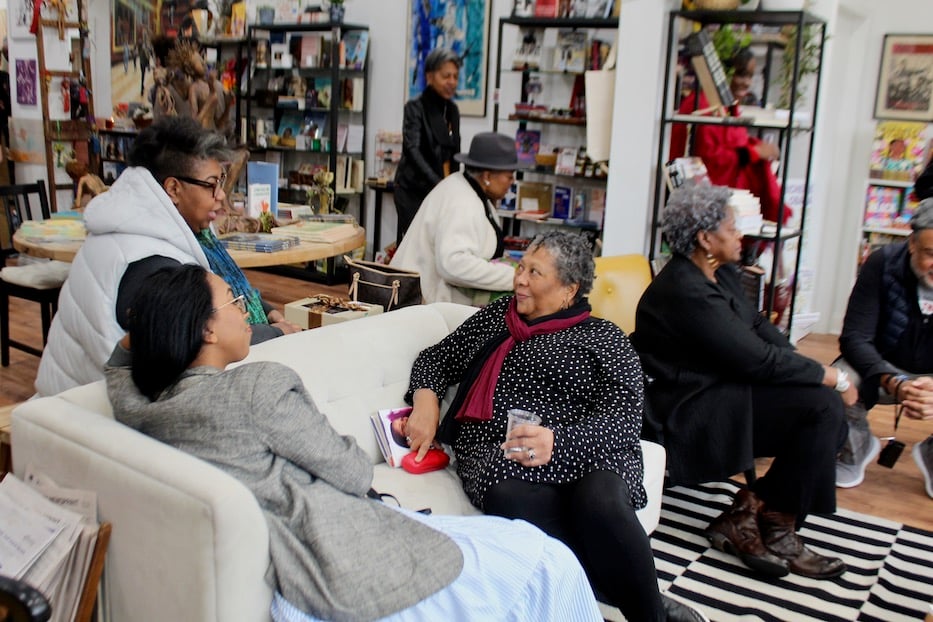
Nelson’s words laid Savage’s life bare, but also painted it with great humanity. Nowhere, perhaps, was the artist’s struggle clearer than in Nelson’s poem “Hitting Bottom,” which wound through the sculptor’s marriage to journalist, Black nationalist and Garveyite Robert Poston. A member of the Universal Negro Improvement Association (UNIA), Poston died at sea coming back from Liberia.
He and others, Nelson said, were discovering that America did not want them as Black people, but Liberia did not, either.
In the poem, written out like an X, Nelson writes with deep feeling about Savage’s love for Poston, the weight of his loss and the premature birth and death of their daughter, Roberta. It is enough to bring a reader to their knees. Saturday, attendees could hear breath still as she read (read the piece in its entirety here).
“That pretty much describes what art was for her,” she said between poems, drawing a connection from Savage to living sculptor Merdith Bergmann to James Weldon Johnson, the composer of “Lift Every Voice and Sing.” “It was one struggle after another.”
The story of Savage, and the miracle of her life, is still unfolding, she added. After her book’s publication, a team she had worked with at the Schomburg Center for Research in Black Culture uncovered several letters from Alain Locke, widely seen as the progenitor and darling of the Harlem Renaissance. The letters revealed that Locke was working to undermine Savage during her lifetime.
“Her life began with having her father stand against her, and then 30, 40 years of fighting to be able to make the art she felt called to make, and then at the end, another major [blow],” she said.
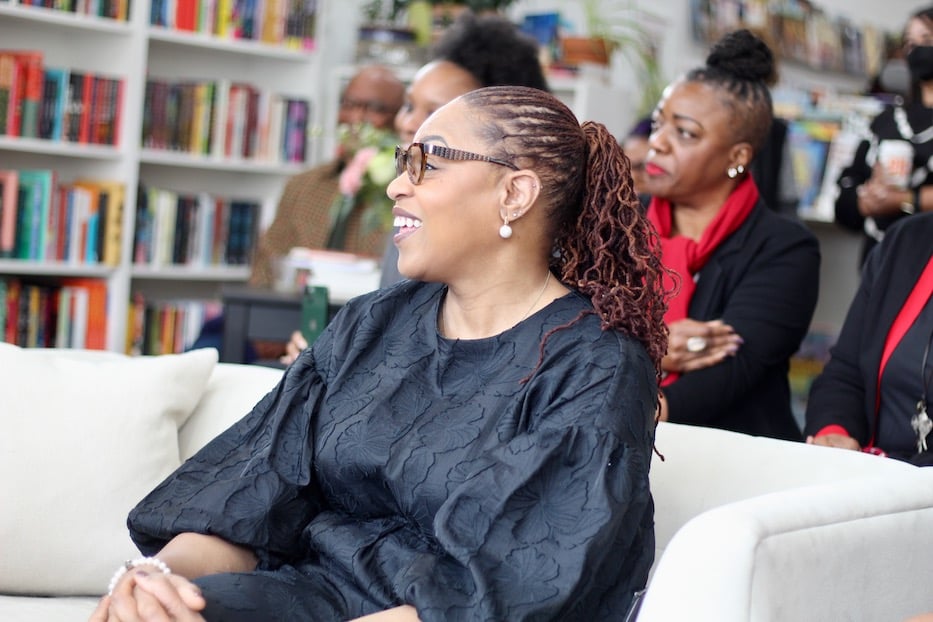
Connecticut Poet Laureate Antoinette Brim-Bell.
The sense of the sacred flitted through the space as Brim-Bell slipped onto the bench, holding the pages of a new manuscript tightly between her hands. Before reading, she promised that she would leave writers in the room with a prompt of their own. Then she turned to Mickens.
“Your artwork is amazing,” she said, her foot rising and falling in an embroidered velvet slipper. “It is important and necessary work, and sometimes, everyone just doesn’t get how necessary and how important it is. So it is revolutionary to step out there, and create the type of art that you do.”
Looking back down at the page, she told attendees that she had been inspired by Wallace Stevens’ “13 Ways of Looking At A Blackbird”—so much so that a series of poems had sprouted from the single piece. Instead of a blackbird, however, she was simply interested in ways of looking. As she read—Gotta see to know/Gotta see to know/Gotta know/To see—she tied spare, sometimes glittering and evocative language to the act of seeing itself.
Suddenly, a listener could hear the act of seeing, with the drum of fingers on wood, or maybe a hard, pointed stare, or the bending sheaves of light into a room.
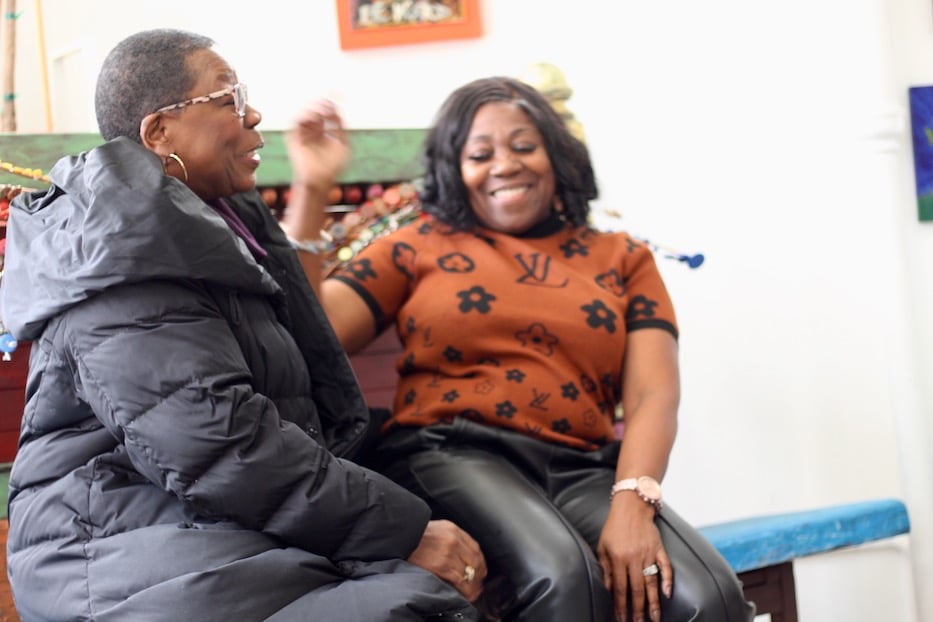
Between works, Brim-Bell took attendees back to her 20s, at a time when she thought she had everything figured out. When she realized she didn’t—”you don’t even realize how young you are, and how precious you are, and how time is gonna move forward and it’s gonna be okay”—she could feel the world shift beneath her. Then one day while she was ironing, she saw an angel.
“It looked like a snow angel that had just lifted up,” she said. “It was all crystalline and shivery and not touching the floor, but almost touching the ceiling, and very very broad. And I wasn’t afraid, and I stood there, and I looked at it, and then it was gone. But on the inside of me, I knew it was gonna be alright.”
Now, she said, she thinks of that moment when the world turns upside down. While she spoke, Mickens’ wings extended behind her. “Angels are still out there,” she said.
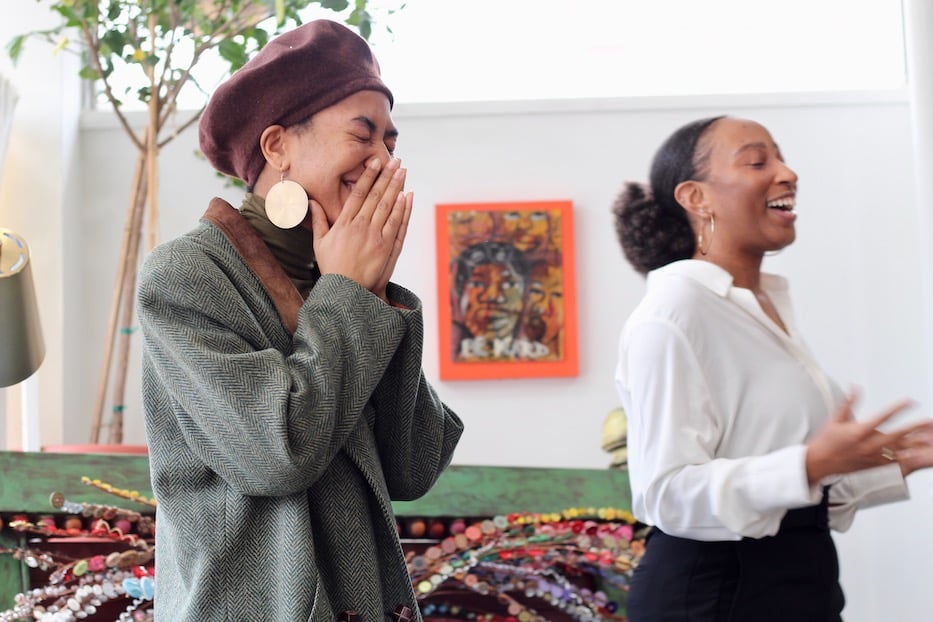
Sha McAllister and Zanaiya Léon.
That sense of the divine echoed through her poetry, meditations on looking informed by years of experience and language that was clear, economical and delicate all at once. Before reading her work “13 Ways Of Looking at a Lock On The Door,” Brim-Bell laughed remembering how little she initially liked Virginia Woolf's A Room of One’s Own. It was only later, when she became a mother herself, that the book began to resonate with her.
It was maybe for that reason that she left listeners with a prompt: “write a love poem to yourself.” As she pulled out her poem “This Female Body” and prepared to read, her voice wove through the bookspace, even and full:
She tends the fruit of her own labor, lays brick upon brick
Weaves what was threadbare into warmth
She says, we are safe now
In honoring community angels, Anderson, Gardin and Mickens all said it was also important to them to spotlight the divine, often quiet work that is taking place in New Haven. “Time is so precious and you have to give people their flowers,” said Karimah Mickens.
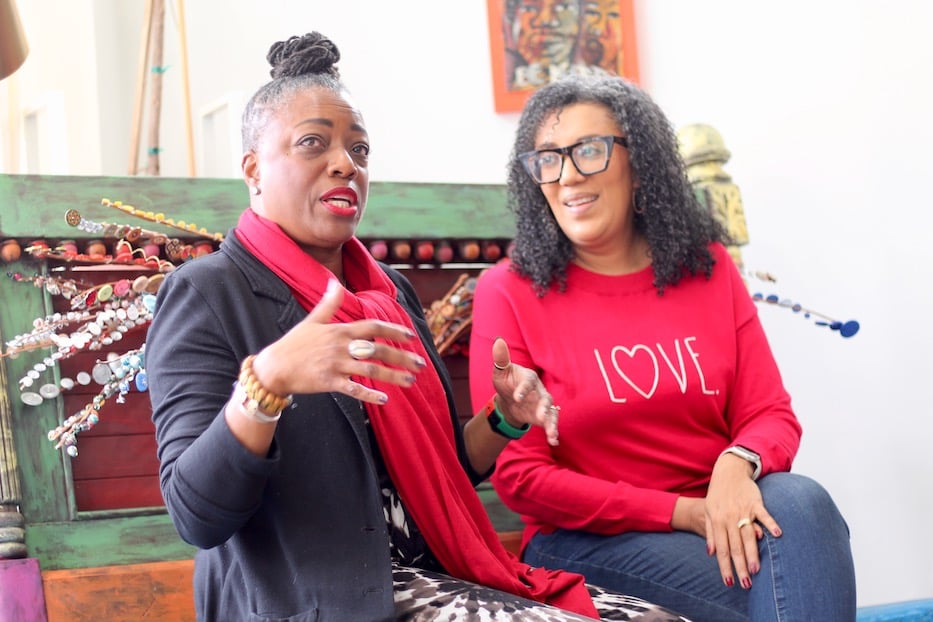
Erica Bradley and Karen DuBois-Walton.
And people did. Introducing DuBois-Walton, Erica Bradley remembered a recent conversation that the two had over the phone. At the time, DuBois-Walton was driving, and would stop to check directions every so often. Bradley made nothing of it. It was only the next day, while scrolling through social media, that she saw that DuBois-Walton had been on her way to meet Vice President Kamala Harris.
“She was on her way to a meeting with the Vice President of the United States and she’s talking to me like she’s on the way to Dunkin’ Donuts!” Bradley said to a wave of laughter that rippled through the room.
Introducing McAllister, Zanaiya Léon recalled meeting an angel close to a decade ago, when she was in New York City to see a family member in the hospital. When she and her mother exited the building, the sky opened up. A man offered to walk them to their car beneath the cover of his umbrella.
Now, Léon doesn’t second-guess it when she feels the divine moving in her life.
“You an angel, sis,” Léon said as McAllister came to the front, trying not to cry. “Do your thing.”
“I just feel so much love,” McAllister said. “God is so good.”

